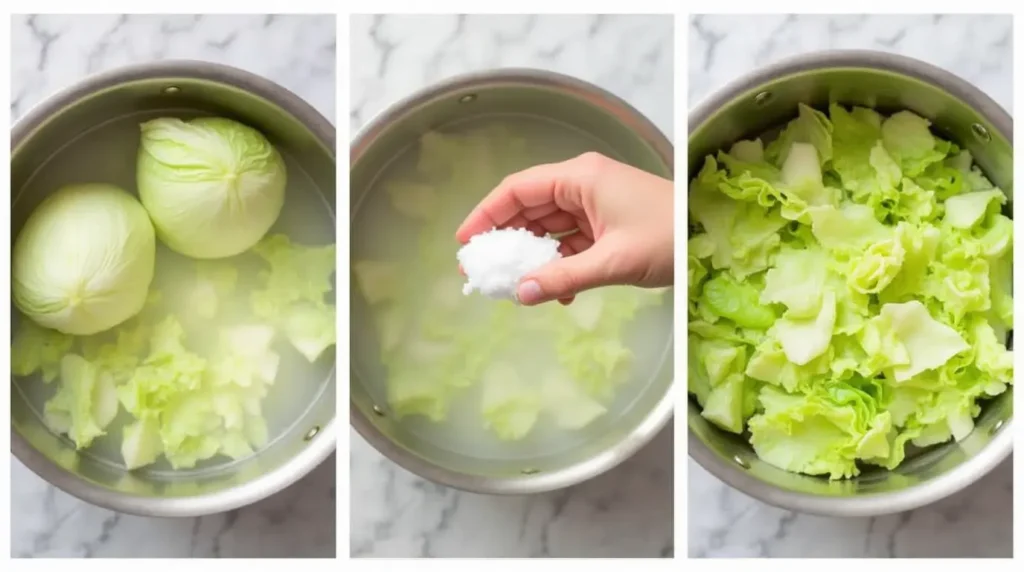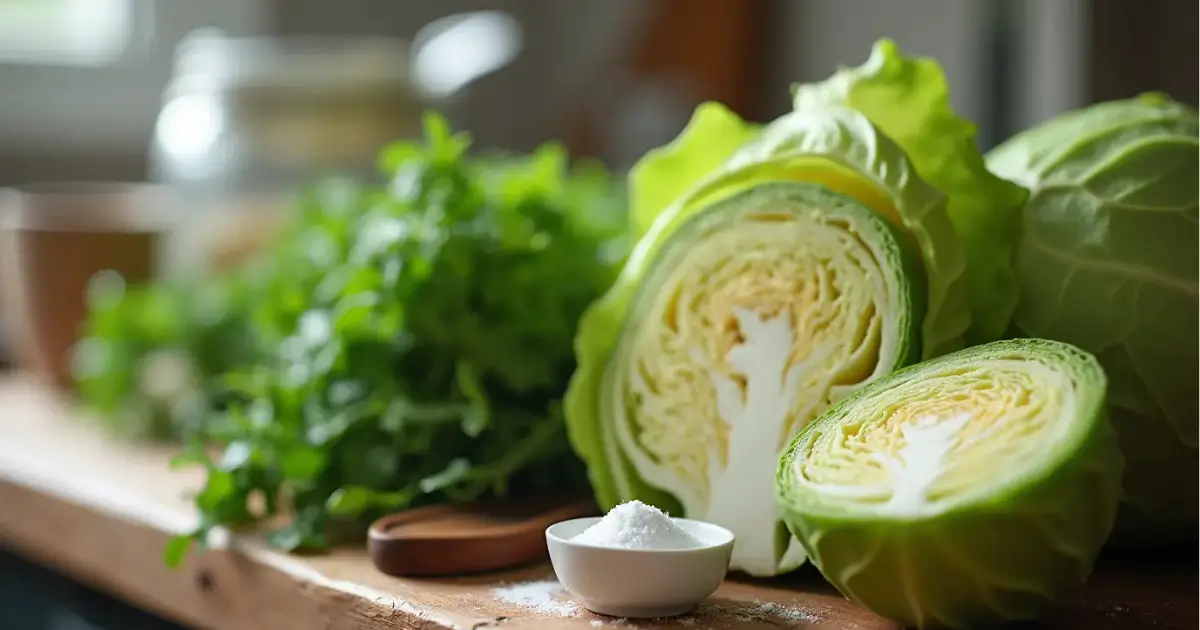Table of Contents
Why do you put baking soda in cabbage? This question has intrigued cooks for generations, sparking curiosity about its effects on this versatile vegetable. Adding baking soda to cabbage while cooking is a debated practice, believed to influence its texture, color, and aroma.
This article dives into the science and history behind using baking soda in cabbage, explains its interaction with the vegetable, and explores its effects on flavor, nutrition, and health. If you’re wondering whether you should try it in your kitchen or avoid it, this comprehensive guide will help you make an informed choice.
Introduction to Why do you put baking soda in cabbage
Cabbage as a Culinary Ingredient
Cabbage is a versatile vegetable used in countless cuisines across the world. From slaws and stir-fries to soups and stews, this humble vegetable holds a special place in many kitchens. Its slightly peppery taste, crunchy texture when raw, and soft, buttery consistency when cooked make it a favorite for chefs and home cooks alike.
Rich in nutrients like vitamin C, fiber, and antioxidants, cabbage is not just delicious but also incredibly healthy. Whether it’s green, red, or savoy, the variety adds to its culinary appeal. But like many vegetables, cabbage can be tricky to cook just right—balancing softness with color retention is often a challenge.
Common Cooking Methods for Cabbage
Cooking cabbage might seem straightforward, but there are multiple techniques to achieve the perfect results. Boiling, steaming, sautéing, and even grilling can bring out different flavors and textures from the vegetable. For instance:
- Boiling: The simplest way to soften cabbage but risks turning it dull and mushy.
- Steaming: Retains nutrients and color better than boiling.
- Sautéing: Adds caramelized flavors and preserves a bit of crunch.
However, one of the most debated techniques involves adding baking soda to the cooking water. While some swear by it for achieving brighter, softer cabbage, others caution against potential downsides.
Understanding Baking Soda
Chemical Composition and Properties of Baking Soda
Baking soda, or sodium bicarbonate, is a household staple known for its versatility. It’s a white, crystalline powder with alkaline properties that make it a powerful ingredient in both cooking and cleaning. When dissolved in water, it increases the pH, creating an alkaline environment.
This chemical reaction is precisely why baking soda is often used in recipes: it can tenderize, neutralize acidity, and even enhance certain colors. However, these same properties can produce mixed results when applied to vegetables like cabbage.
Common Culinary Uses of Baking Soda
In the kitchen, baking soda isn’t just for cookies! It’s a go-to for multiple tasks:
- Tenderizing Meat: Its alkaline properties break down proteins, making meats softer.
- Leavening Agent: In baked goods, it creates air bubbles for fluffier results.
- Neutralizing Acidity: Helps balance overly acidic dishes like tomato sauce.
When applied to cabbage, baking soda can have specific effects, which we’ll explore further. Whether you’re striving for brighter greens or quicker cooking times, understanding the science behind it is key.
The Role of Baking Soda in Cooking Cabbage
Why Do People Add Baking Soda to Cabbage?
Historical Context and Traditional Practices
For centuries, cooks have sought ways to enhance the cooking process, and adding baking soda to cabbage is one such tradition. This practice dates back to when vibrant, visually appealing dishes were prized in both home kitchens and restaurants. By altering the cooking water’s pH, cooks could achieve greener, softer cabbage, which was considered more appealing on the plate.
In the past, resources were limited, and quick cooking methods were essential. Baking soda sped up the cooking process, making it a practical choice for time-strapped households. Furthermore, the unpleasant odor that cabbage sometimes emits during cooking was believed to be reduced with a pinch of baking soda.
Intended Effects on Texture and Color
Baking soda primarily targets two common cooking concerns: texture and color. The alkaline nature of sodium bicarbonate softens the tough fibers of cabbage, making it easier to chew and digest. Additionally, it preserves the bright green hue of cabbage, preventing the dull, grayish-green color often associated with overcooked vegetables.
The vibrant appearance is particularly significant in dishes where presentation matters. Yet, despite these benefits, modern cooking practices emphasize caution due to potential nutritional and flavor compromises.
Chemical Reactions Between Baking Soda and Cabbage
Alkaline Environment Effects on Cabbage’s Cellular Structure
When cabbage is exposed to baking soda, its cell walls, primarily composed of cellulose and hemicellulose, begin to break down. The high pH weakens these structures, leading to a softer texture. This process makes cabbage easier to eat and ideal for recipes that demand tender vegetables.

However, this softening comes with a trade-off. Excessive use of baking soda can lead to overly broken-down structures, turning cabbage mushy and unappetizing. It’s a delicate balance that requires careful measurement.
Impact on Chlorophyll and Color Retention
One of the more visually striking effects of baking soda is its ability to retain and even enhance the green color of cabbage. Chlorophyll, the pigment responsible for the vegetable’s color, is sensitive to pH levels. In acidic environments, chlorophyll degrades, producing a dull color. Baking soda, being alkaline, neutralizes this effect, allowing chlorophyll to stay intact.
This mechanism is why cabbage cooked with baking soda often appears brighter and more vibrant. While visually appealing, the bright green hue may come at the cost of a slightly altered flavor profile.
Impact on Cooking Time and Texture
How Baking Soda Accelerates Softening
Cabbage’s dense cellular structure can take time to break down during cooking. By raising the water’s pH, baking soda speeds up this process. The cellulose and lignin in the cabbage soften faster in an alkaline solution, reducing cooking times and conserving energy.
For recipes requiring a smooth texture, such as soups or purees, this technique is especially effective. The faster breakdown can also be helpful when preparing cabbage for babies or individuals with difficulty chewing.
Potential for Over-Softening and Mushiness
However, the very property that makes baking soda effective can also lead to over-softened, mushy cabbage. If too much baking soda is added or cooking time is prolonged, the cabbage can lose its structure entirely. Instead of tender leaves, you might end up with a limp, unappetizing mess.
This risk underscores the importance of precision. A small pinch of baking soda can work wonders, but too much can ruin your dish. For those seeking to retain some crunch, alternative methods may be preferable.
Nutritional and Health Implications
Nutrient Retention in Cabbage Cooked with Baking Soda
Effects on Vitamin C and B1 Stability
While baking soda can enhance texture and color, it has a downside: it accelerates the breakdown of certain nutrients, particularly vitamin C and B1. These water-soluble vitamins are sensitive to heat and alkaline conditions, leading to significant losses during cooking.
Vitamin C, an essential antioxidant, can degrade by up to 90% when cabbage is cooked in a baking soda solution. B1, or thiamine, is another casualty, as it cannot withstand the elevated pH levels. As a result, the health benefits of cabbage may be diminished.
Overall Nutritional Profile Changes
Beyond vitamins, other nutrients in cabbage, such as polyphenols and antioxidants, may also be affected by the alkalinity of baking soda. The cooking process alters the chemical composition of these compounds, reducing their potency and bioavailability.
Though baking soda might improve visual and textural qualities, it’s important to weigh these benefits against potential nutritional losses. Modern chefs often opt for steaming or blanching to minimize nutrient degradation while maintaining desirable textures.
Health Considerations
Sodium Content Implications
Baking soda introduces sodium into the cooking process, which can be a concern for individuals monitoring their sodium intake. Although the amount used in cooking cabbage is typically small, it’s worth considering if you’re on a low-sodium diet or managing conditions like hypertension.
Reducing the amount of baking soda or opting for alternative methods can help you enjoy cabbage without significantly increasing your sodium consumption.
Potential Digestive Effects
For some individuals, cabbage can cause digestive discomfort, such as gas or bloating. Baking soda may help by reducing sulfur compounds in cabbage, which are partly responsible for its strong aroma and digestive side effects.
While this is a potential benefit, it doesn’t work for everyone. The impact of baking soda on digestion can vary depending on individual tolerance, and excessive consumption might even upset the stomach. Moderation and balance remain key.
Sensory and Culinary Outcomes
Flavor Alterations
How Baking Soda Affects Cabbage’s Natural Taste
The addition of baking soda to cabbage undeniably impacts its flavor. Cabbage has a natural, mildly sweet, and earthy taste that transforms during cooking due to heat and the breakdown of compounds like glucosinolates. When baking soda is introduced, the alkaline environment intensifies these changes.
The softened texture achieved through baking soda can enhance the perception of sweetness by reducing the bitterness commonly associated with cooked cabbage. This can make the vegetable more palatable to some. However, for purists who love the earthy undertones of natural cabbage, the change in flavor might feel artificial or overpowering.
The alteration is subtle yet significant, especially in dishes where cabbage serves as the main ingredient. While the taste may appeal to some, others might find it lacking the characteristic complexity that cabbage brings to recipes.
Risk of Developing Off-Flavors
One of the drawbacks of using baking soda is the potential for off-flavors. If too much baking soda is added, the cabbage may develop a slightly soapy or metallic aftertaste. This happens because the alkaline environment interacts with the sulfur compounds in cabbage, creating byproducts that affect flavor negatively.
Overcooking cabbage with baking soda exacerbates this issue. Instead of enhancing the vegetable’s natural sweetness, prolonged exposure to an alkaline environment can lead to an unappetizing, flat taste. Balancing the amount of baking soda and closely monitoring the cooking time are crucial to avoid these pitfalls.
Aroma Control
Baking Soda’s Role in Reducing Cooking Odors
Cabbage’s strong odor during cooking is often a deterrent for some home cooks. This pungent smell comes from sulfur-containing compounds like hydrogen sulfide, which are released as the cabbage cooks. Baking soda can play a role in reducing these odors, making the cooking process more pleasant.
The alkaline nature of baking soda neutralizes some of these sulfur compounds, effectively diminishing their intensity. This is particularly helpful in smaller kitchens or shared spaces where strong odors might linger. As a result, the cooking environment becomes less overwhelming, and the dish becomes more approachable for sensitive noses.
However, this odor-reduction benefit isn’t without trade-offs. The very compounds that cause the smell also contribute to cabbage’s distinct flavor profile. Reducing them too much can strip the dish of its natural aroma, leading to a less flavorful outcome.
Alternative Methods for Odor Control
For those who prefer not to use baking soda, there are alternative methods to manage cabbage’s cooking odors:
- Vinegar or Lemon Juice: Adding a small amount of acid to the cooking water can help counteract the smell without significantly altering the flavor.
- Ventilation: Proper kitchen ventilation or cooking with a lid slightly ajar helps dissipate the sulfuric odors quickly.
- Quick Cooking Methods: Techniques like steaming or blanching minimize the release of sulfur compounds by reducing cooking time.
- Potatoes: Adding a few chunks of raw potato to the pot can absorb some of the sulfur compounds, lessening the intensity of the odor.
Each method has its pros and cons, and the choice depends on personal preferences and the specific dish being prepared. Whether using baking soda or these alternatives, controlling cabbage’s aroma is entirely achievable with a few simple tweaks.
PAlternative Methods and Best Practices
Steaming and Blanching Methods
Steaming and blanching are great alternatives to using baking soda for cooking cabbage. These methods preserve the cabbage’s vibrant color and maintain more nutrients compared to boiling. Steaming uses minimal water, retaining vitamins like C and B1, while maintaining texture and flavor. Blanching involves briefly boiling cabbage, then cooling it in ice water, which locks in color, reduces bitterness, and keeps the cabbage crisp.
Use of Acidic Ingredients Like Vinegar or Lemon Juice
Acidic ingredients like vinegar or lemon juice are safer, healthier options for enhancing cabbage. A splash of acid in the cooking water stabilizes chlorophyll, preserving the vegetable’s bright green hue without compromising its nutrients. These ingredients add a subtle tang that complements cabbage’s natural sweetness, elevating its flavor without the risks associated with baking soda.
Optimal Cooking Times and Temperatures
Proper timing preserves cabbage’s nutrients and texture.
- Boiling: 8–10 minutes for tender, firm results.
- Steaming: 5–7 minutes to retain crunch and nutrients.
- Sautéing: 4–5 minutes for caramelized flavors.
Cooking at moderate temperatures prevents over-softening and reduces unpleasant odors. Remove cabbage from heat promptly for the best results.
Seasoning and Flavor Enhancement
Enhance cabbage’s flavor with:

- Salt and Pepper: For balance and a slight kick.
- Garlic and Onions: For savory depth.
- Herbs and Spices: Dill, thyme, or turmeric for aromatic notes.
- Butter or Olive Oil: For richness.
- Acidic Finishes: Lemon or vinegar to brighten flavors.
Experimenting with these seasonings transforms cabbage into a flavorful, nutrient-rich dish.
Frequently Asked Questions
Does Adding Baking Soda to Cabbage Reduce Gas?
Yes, baking soda can reduce gas-inducing compounds in cabbage by neutralizing sulfur compounds released during cooking. However, results vary by individual digestion and portion size. Pairing cabbage with fennel or ginger or using gentler methods like steaming may also help.
Is It Safe to Use Baking Soda When Cooking Cabbage?
Using a pinch of baking soda is safe but overuse can alter taste, texture, and nutrients. Its alkalinity might also neutralize stomach acid. For a safer approach, try steaming or using acidic ingredients.
How Much Baking Soda Should I Add to Cabbage?
Add 1/4 to 1/2 teaspoon of baking soda per quart of water. Too much may create a soapy taste or mushy texture. Always use sparingly and taste-test as you go.
Are There Healthier Alternatives to Using Baking Soda with Cabbage?
Yes! Steaming or blanching retains nutrients and texture. Vinegar or lemon juice enhances color naturally. Seasonings like garlic and ginger can manage odor without compromising health or flavor.
What Are the Effects of Baking Soda on Red vs. Green Cabbage?
Baking soda brightens green cabbage by preserving chlorophyll but can turn red cabbage bluish due to pH sensitivity. Use acidic ingredients to keep red cabbage vibrant.
Can Baking Soda Affect the Color of Cooked Cabbage?
Yes, baking soda enhances green cabbage’s color by stabilizing chlorophyll but may cause an unnatural hue if overused. In red cabbage, it alters anthocyanins, creating a bluish tint. Minimal use avoids these extremes.
Conclusion:
Using baking soda to cook cabbage has its perks, like faster softening, vibrant color retention, and reduced cooking odors. However, it can also lead to nutrient loss, mushy texture, and altered flavors if overused. Alternatives like steaming, blanching, or adding acidic ingredients like vinegar are healthier and equally effective for preserving cabbage’s taste and nutritional value.
Ultimately, the best method depends on your preferences. A small pinch of baking soda works if you’re aiming for soft, colorful cabbage, but natural techniques can often achieve better results without the drawbacks. Whichever method you choose, cabbage remains a versatile, delicious, and nutritious addition to your meals!

